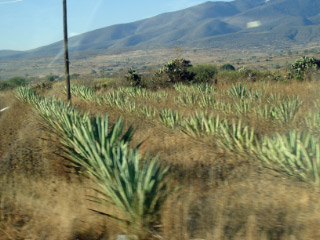

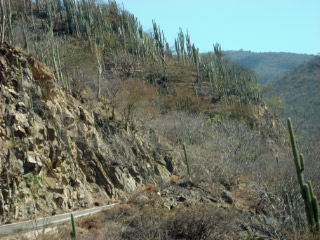
Chapter 6. Isthmus of Tehuantepec



(Bert) One of our prettiest drives, it is a scene probably few tourists visit. No resorts, no airports, no cities, only a few buses and trucks, tiny widely-distant villages and thousands of blue agave plants. Mountain slopes are patched with neat rows of agave sticking from the bare ground like giant tops of pineapples. Early after our departure from Oaxaca we pass through the most intense cultivation of agave and numerous family-run Fabrica de Mezcal with white smoke funneling into the blue skies, the agave leaves burning in pit fires. One village is nearly hidden below a cloud of dark smoke where the factories are most numerous. Dozens of roadside shops are dedicated to selling mescal. Beyond the agave fields, the mountains are covered in cacti, mostly those that resemble saguaro, but without arms. The road seems to a perpetual succession of turns, ascents and descents, up and around the giant porcupine-quilled mountains. At many high points we can scan across a receding series of mountains, each a different shade of purple. In the valleys where a stream trickles or a larger one spreads in a web of shallow waterways, the trees grow tall and lushly yellow-green, in sharp contrast to the desert dry mountainsides.
We stop at Rio Hondo for an hour-long lunch break which many of us dedicate to birding, grabbing a quick sandwich before or after. Many get up to four life birds from the bridge, looking down to the wooded stream or up to the cliffs. Best are two Great Black-Hawks, a Russet-crowned Motmot, many White-throated Magpie-Jays, three Rufous-naped Wrens, Streak-backed Oriole and several Yellow-winged Caciques.
Later in a bird count at the margarita party, Larry, who is becoming a real birder, reports seen a Lesser Roadrunner at KM 138. Two of us spotted an Orange-breasted Bunting flying across the road. Leaving Oaxaca, Shari tells me she scrapped frost from the car window, but now we’ve traveled to the hot country of Tehuantepec. Tonight, parked under a spreading canopy of old trees, it is cool enough to be comfortable. Shari encourages me to call out a Ferruginous Pygmy-Owl. This time I get two to fly to the trees above us. Darkness has set in and we try to find the owls in the dense foliage, when Tom hears another call. Then I hear it too and announce Pacific Screech-Owl. Calling from the treeline along the irrigation canal, I tramp through the tall grass and point my high beam on the spot. The screech-owl stares back at us. We watch it long enough for most of the group to gather at the spot and see the highlighted little owl with the red eyes. Janice goes back to get Mike and Jill, but by that time they return the show is long over. Fortunately, Paul was carrying his 600-mm camera setup and gets an excellent photo.
(Shari) “Three lifers and a nap to boot!” reports Jim about our lunch stop
today. Janice says that the Copper Canyon cannot beat our drive today. The
scenery is beautiful as we descend, descend, descend from 7400 ft. to sea level.
Winding through canyons and around mountain sides we coast our way to
Tehuantepec.
Small fields of the agave plants abound alongside mom and pop mescal
manufacturing places. The air sometimes is thick with smoke as the cactus is
burnt to achieve the distinctive smoky taste. Before our margarita hour, Bert
presents Birding 303 - how to identify birds from notes - and then with my
prompting, tells the group about the next two days of birding. Gordon says he
does not want to go birding if all he is going to see is a Lesser Ground
Squirrel. Too many margaritas made me say that instead of the Lesser
Ground-Cuckoo. It gets sillier as the minutes pass. Heather has had eight
lessons on the violin and brings it out to serenade us with “Twinkle, Twinkle
Little Star”. John admits he plays the violin so Heather gives the instrument to
him. He spends a few minutes tuning it and we all wait in anticipation for some
great solo. He hands the violin back to Heather and says, “There, now it is
tuned”. I feel gypped. I have had social groups before, but never have had so
many people wanting to hang out until dark. Finally Bert agrees to call in the
owl that never fails him at this location. Soon we hear hooting from the trees
and at least three owls are called in. I loose patience when we cannot see them
and go inside to make supper. Bert returns reporting that the group got
spectacular looks at the Pacific Screech-Owl. Darn, you snooze, you loose. I
need more patience I guess.
(Bert) Fierce winds affront us when we step out of the cars at Boca del Rio
where La Ventosa Lagoon meets the Pacific Ocean. It takes me only a minute to
decide we are not going to start birding here. We hustle back inside and drive
to the opposite end of the lagoon. Even here the winds are strong, although much
diminished when we walk through the thorn forest, an apt name for sharp needles
projecting from brush and short trees, mostly Palo Verde. Some of the needles
are 4-in. stilettos, sharp enough to inflict damage when stepped on with
thin-soled shoes, as some find out. I catch a more ordinary needle in my thigh
and it is like a bee sting that can be felt for hours. The winds keep the birds
tight in the bushes and when they do take flight they clumsily flap their wings
in a fruitless attempt at stability. Nonetheless, we do identify White-lored
Gnatcatchers,
Streak-backed Orioles and Orange-breasted Buntings. A high-flying Peregrine
Falcon has no trouble dealing with the winds. We walk back to the cars, checking
the river long enough to see Green Heron, Common Moorhen and a flock of
Black-bellied Whistling-Ducks, the latter being a target bird for Paul and Pat.
Our real goal of the morning is Lesser Ground-Cuckoo, since the Tehuantepec area is the best place in Mexico to find this elusive relative of the roadrunner and I’ve seen them before at La Ventosa Lagoon. We drive back to the spot we aborted earlier this morning and this time hike inland through the thorn forest. The sun is intense now, but there is enough of a breeze penetrating the brush to stave off sweating. An hour’s search turns up numerous Inca Doves and ground-doves. At 11:30, most are tired and ready to hike back to the cars, but Tom, Charlu, Gordon and Maxine continue on through good ground-cuckoo habitat. On our way back, Heather spots a low flying bird and attempts to name it, but I jump to the gun and say “thrasher”, to which she agrees. We all see the short flight and the dip into the cactus patch. On replaying in my mind what I saw, I know it is not a thrasher and Ken and I approach the cactus beneath the thorn forest canopy. I rattle a fallen tree limb and up pops the bird and flies to a low limb, giving me a momentary look, and then continues deep into the forest. It is plenty of view for me to recognize what I saw and I go back to the others, open the book to Plate 24 and with my thumb covering the mascara blue eye, they all agree the body profile and coloring they saw matches the Lesser Ground-Cuckoo. For Bob and Heather, the ground-cuckoo is life bird number 600!
Back at the windy part of the lagoon, it is still hard to stand erect without loosing balance and binoculars are only steady if I brace them across the car hood. We get our view of the Pacific Ocean, watch the Magnificent Frigatebirds dance in the airstream and Reddish Egrets feed on the muddy lagoon edge with their backs to the wind.
(Shari) I wake up with a toothache that gets worse as the day progresses. I think it is the cracked tooth that needs a root canal and crown. Jane, Dee and I join Larry and Marlene to sightsee the area. We are the only ones left in camp after the birders departed this morning. We negotiate the narrow streets of Tehuantepec on this Saturday morning market day but find no large grocery store. I ask at a hotel “Donde es una tienda grande.” I am surprised that I am understood and the answer comes back with a lot of Spanish of which I understand that there is no large grocery in Tehuantepec and the nearest one is in a town called Salina Cruz and it is a Bodega. We decide to drive to it. Marlene wants to see the Pacific Ocean. We head west until we can go no more. Since I have driven with Marlene and Larry before, I brought my GPS and she says we are in the ocean but all we see is a wall. We drive for a mile or so along the wall trying to peak through grates and openings but we see only a ship in the distance and no ocean. We assume the ship is floating on the water. We find the Bodega and fill up on groceries before stopping at a hole-in-the-wall place with three tables for lunch. Four of us order “Pazole”, a delicious tomato base broth filled with pork and chick peas. Returning home I am surprised to find the birders back. Apparently it was too windy. By now my tooth is killing me so I decide to take some penicillin I have along with me. At 6, Larry sets up a tripod grill over an open fire and donates kielbasa for the group. Everyone brings what they want to eat with the kielbasa and we sit and chat around the fire until well into dark.
(Bert) The Pacific Ocean breeze extends to the Tehuantepec foothills, twenty miles inland, a welcome cooling effect that keeps the early morning temperatures pleasant. The newly graveled road passes thorn forest on both sides and we stop frequently to seek birds. As I remember from previous visits, the habitat seems almost devoid of avian life until I start whistling the monotonous call of the Ferruginous Pygmy-Owl. The first to arrive are always the curious White-lored Gnatcatchers and at some stops that is almost all we get.
Gordon sees a bird make a short flight and suspects it is a Lesser
Ground-Cuckoo. We walk toward the spot and I notice other birds in the area, so
I issue my owl call again. In come the gnatcatchers, many Orange-breasted
Buntings, a few female Rose-bellied Buntings, a couple of Broad-billed
Hummingbirds – the local and distinctive subspecies being Doubleday’s
Hummingbird – as well as Golden-fronted Woodpeckers, Brown-crested Flycatchers
,
Streak-backed and Altamira orioles. A Ferruginous Pygmy-Owl calls in response
and soon moves in closer to me. Someone spots the owl and soon everyone is
clambering to see the owl through the dense thorn forest. I try to make sure
everyone has seen the Rose-bellied Bunting, but the owl has their interest. For
someone who has seen neither, the tiny 6.5-in. owl is more exciting. To someone
who has seen hundreds of these owls and knows how narrow is the range of the
bunting, Rosita’s Bunting – its alias – is the rare find.
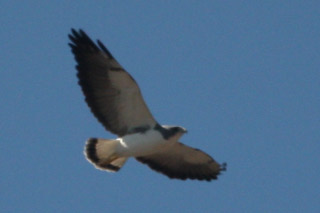 We walk down a two-track that narrows to a trail tight enough to brush
painfully past thorns. I see a running Lesser Ground-Cuckoo and quickly announce
it so that most of the others see it too. We continue to fend our way through
the thorns, hoping for another look. Gordon sees it twice more. Bob comes up
with a report that hunters are in the area and we retreat to the cars. All
except Tom, that is, and when the rest of us are all inside the cars, we here
Tom on the radio saying he has the cuckoo in sight. I tell him about the hunters
and when he hears gunfire he decides to forsake the cuckoo. Later we meet a man
with an INAH badge sown on his shirt and he tells us the men are hunting
javelinas and other animals, but that it is illegal. We continue down the road,
still hearing the hunters shouting as they spread across the mountain slope
trying to arouse the animals.
We walk down a two-track that narrows to a trail tight enough to brush
painfully past thorns. I see a running Lesser Ground-Cuckoo and quickly announce
it so that most of the others see it too. We continue to fend our way through
the thorns, hoping for another look. Gordon sees it twice more. Bob comes up
with a report that hunters are in the area and we retreat to the cars. All
except Tom, that is, and when the rest of us are all inside the cars, we here
Tom on the radio saying he has the cuckoo in sight. I tell him about the hunters
and when he hears gunfire he decides to forsake the cuckoo. Later we meet a man
with an INAH badge sown on his shirt and he tells us the men are hunting
javelinas and other animals, but that it is illegal. We continue down the road,
still hearing the hunters shouting as they spread across the mountain slope
trying to arouse the animals.
A large Caterpillar is parked beside the road just as it begins a steep ascent. I’ve always stopped at this point because the road was nearly impassible except by motorcycle. Now recently leveled and widened, we continue to the dead end and the footpath to an ancient ruins site. High on the cliff we can scan the flat coastal plain all the way to Tehuantepec and the petroleum refinery on the lagoon we were yesterday. The vegetation looks lush from here, but I know from experience it is brittle dry thorn forest at ground level. An adult White-tailed Hawk soars in the uplift and is nearly eyelevel with us.

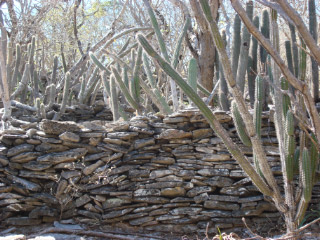
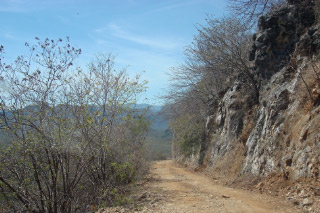
Some of us climb the steep path leading to the ruins. Except for the path,
nothing has been restored. We walk past layered limestone rocks, a few inches
thick and a foot or more in length and width, stacked to make an interleaving
wall. Most walls are only waist height and outline rooms. It appears to be the
dwellings of the lower caste and even after walking more than a mile we do not
come to richer dwellings or temples. Perhaps they are higher still, with an
overlook of the surroundings for protection. I wonder what culture built this
city. On the downhill return, I find Canyon Wren, a pair of Beautiful
Hummingbirds and I watch a calling Russet-crowned Motmot.
Most leave at noon, when my car thermometer registers 98º. As we descend to the coastal elevation it rises to 104º, but soon comes back down again. A few of us try one more spot in hopes of attracting Cinnamon-tailed Sparrow, but the midday heat has suspended life. Near camp, just before sunset we visit a Cattle Egret roost and see a thousand gather in large trees along a canal, finding also late hunting White-tailed Kites and early rising Lesser Nighthawks. In the evening from my bed I hear a Ferruginous Pygmy-Owl and a Pacific Screech-Owl in the trees beneath where we sleep.